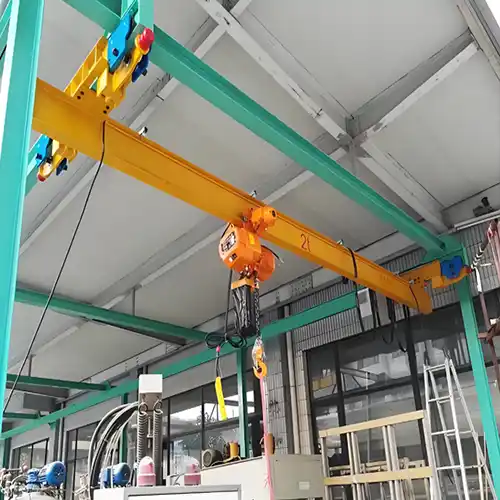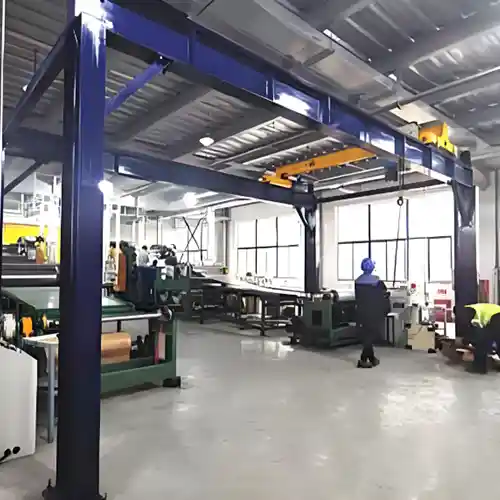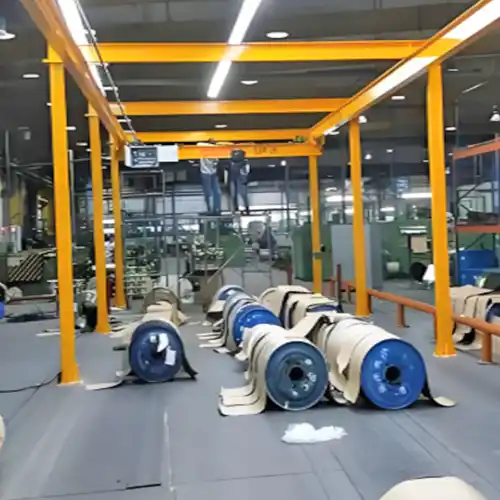Free Standing Bridge Crane vs Freestanding Gantry Crane
Compare freestanding bridge and freestanding gantry cranes to choose the ideal solution for your workspace layout, lifting needs,& installation conditions.
Category: Featured
Your Trusted Free Standing Overhead Crane Manufacturer & Supplier
Free Standing Bridge Crane vs Freestanding Gantry Crane
Which One Fits Your Facility Better?
Introduction: Choosing the Right Crane When Your Facility Has No Structural Support
If your facility doesn’t have the overhead structure needed to support a traditional ceiling-mounted crane, a freestanding crane is often the best solution. These cranes come with their own support columns, so they don’t rely on your building’s roof or walls. This makes them ideal for older buildings, leased spaces, or workshops with light or no overhead support.
Picking the right type of freestanding crane is important because it affects not just safety, but also how smoothly your operation runs and how much you’ll spend in the long run. A poorly matched crane can cause delays, increase maintenance costs, or even put workers at risk.
There are two main types you’ll hear about: freestanding bridge cranes and freestanding gantry cranes. Each has its own strengths and fits different types of facilities and material handling needs. Knowing the differences helps you pick a crane that fits your space, your workflow, and your budget.
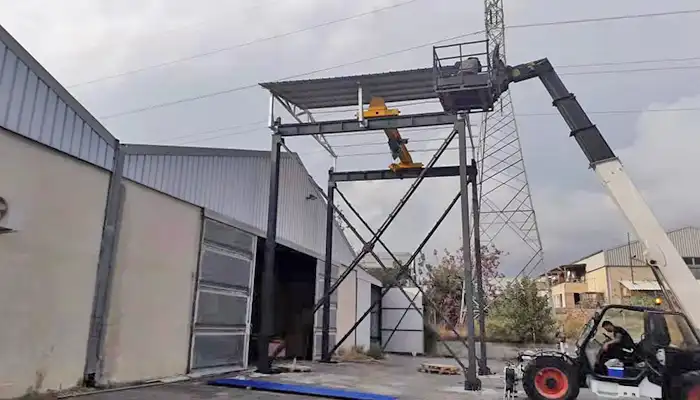
A freestanding bridge crane is a type of overhead crane that supports itself independently of the building structure. It stands on sturdy vertical columns that hold up the horizontal bridge beam, along which the hoist travels to lift and move loads.
This design makes it ideal for indoor facilities that lack roof or wall support strong enough for ceiling-mounted cranes. It offers the same overhead lifting capabilities but doesn't require costly building modifications.
Common applications include:
- Manufacturing plants
- Warehouses
- Maintenance workshops
In these settings, freestanding bridge cranes improve material handling efficiency by enabling smooth, safe lifting without relying on existing building infrastructure.
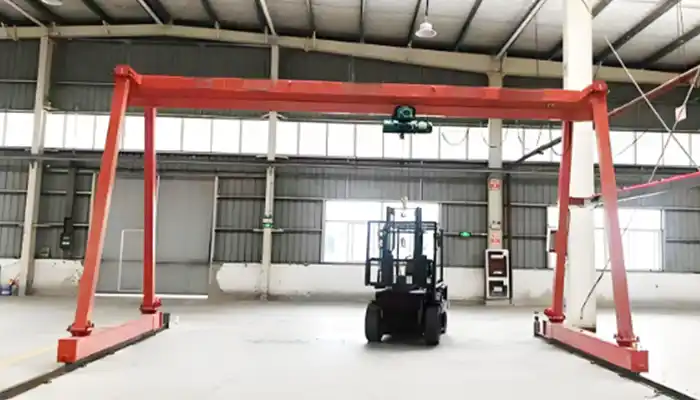
A freestanding gantry crane is a crane system where the bridge is supported by legs that run along rails fixed to the floor. Unlike bridge cranes, which rely on columns fixed in one spot, gantry cranes can often move along the rails, giving you flexibility to cover different areas.
These cranes work well both indoors and outdoors. Their mobility makes them especially useful in places where you need to move heavy loads across a yard or between different workstations, or where the ground layout isn't uniform.
You'll typically see freestanding gantry cranes in:
- Loading docks
- Fabrication yards
- Workshops with uneven floors or changing layouts
Because they don’t require permanent structural support, gantry cranes are a popular choice when you need a lifting system that adapts to shifting workflows or temporary setups.
Facility Factors: How to Decide Which Crane Fits Your Space
When it comes to choosing between a freestanding bridge crane and a freestanding gantry crane, your facility’s layout and conditions play a big role. Let’s look at the main points to consider.
Floor Space and Layout
Freestanding bridge cranes use fixed columns, so they take up less floor space. This makes them great for tight spots or narrow aisles since they don’t block much of the workspace.
Gantry cranes have legs that run on rails right on the floor. That means you need plenty of clear space not just for the crane, but also for its legs and the rails. If your floor is already crowded with equipment or storage, gantry cranes might be harder to fit.
- Bridge cranes require less floor space
- Gantry cranes need clear paths for rails and legs
- Crowded floors favor bridge cranes for better space use
Ceiling Height and Headroom
If your facility has low ceilings, a freestanding bridge crane usually works better. It needs less vertical space because the hoist runs closer to the ceiling, giving you more usable lifting height.
Gantry cranes tend to be taller because of their leg supports. They need more overhead clearance, so if your ceilings are low, this can be a limitation. However, if you have a high ceiling or work outdoors, gantry cranes won’t be an issue.
- Bridge cranes fit well in low-clearance spaces
- Gantry cranes require higher ceilings or open-air use
Floor Strength and Foundation
Both crane types need a strong, flat concrete floor to safely handle the weight of the crane and the loads.Gantry cranes usually require longer rails that have to be firmly bolted to the floor, meaning more foundation work and careful installation.Bridge cranes need sturdy concrete pads under their columns, but overall foundation work tends to be less involved.
- Strong, level concrete is a must for both cranes
- Gantry cranes often need more extensive foundation and rail installation
- Bridge cranes need solid pads under support columns
Indoor vs. Outdoor Use
Freestanding bridge cranes are mostly designed for indoor use where they’re protected from weather conditions.
Gantry cranes offer more flexibility. They can be used both indoors and outdoors. With proper weatherproofing, gantry cranes handle rain, wind, and other outdoor elements well.
- Bridge cranes mainly for indoor environments
- Gantry cranes suitable for indoor or outdoor use with weatherproofing
Considering these factors will help you decide which crane type best fits your space and operational needs.
| Facility Factor | Freestanding Bridge Crane | Freestanding Gantry Crane |
|---|---|---|
| Floor Space and Layout | Takes up less floor space with fixed support columns; ideal for tight or narrow aisles | Requires clear floor space for legs and rails; needs room for crane travel path |
| Ceiling Height and Headroom | Needs less height clearance; hoist runs closer to ceiling, suitable for low ceilings | Taller due to leg supports; needs more overhead clearance, better for high ceilings or outdoor use |
| Floor Strength and Foundation | Requires strong concrete pads under columns; generally less foundation work | Needs strong concrete floor plus longer rails bolted to floor; more extensive foundation needed |
| Indoor vs. Outdoor Use | Mainly designed for indoor use with protection from weather | Can be used indoors or outdoors; with weatherproofing, handles outdoor conditions well |
Material Handling Needs and Operational Considerations: Matching Crane Type to Your Workload
Choosing the right crane depends a lot on what you actually need to lift and how often you do it. Let’s break down the key things to think about so you get the best fit for your operation.
Load Capacities
Both freestanding bridge cranes and gantry cranes cover a wide range of lifting weights—from light loads around 1 ton all the way up to heavy lifts over 20 tons. The trick is to pick a crane that comfortably handles your heaviest loads, plus a little extra for safety.
- Suitable for loads from 1 ton to 20+ tons
- Choose a capacity with a safety margin, typically 20–30% more than your max load
- Both crane types can be customized to meet specific weight requirements
Lift Frequency and Operation
How often you lift matters. If you’re moving materials on a production line or in a process that requires the same lift repeatedly, a freestanding bridge crane usually fits better. Its fixed bridge and columns give you smooth, reliable movement along a set path.
If your lifts are more occasional or you need to move the crane around to different spots, a gantry crane might be the way to go. Gantry cranes can be portable or rail-mounted, so they work well when your lifting points change or you don’t have a fixed workflow.
- Bridge cranes ideal for frequent, repetitive lifting
- Gantry cranes suited for occasional or mobile lifting needs
- Gantry cranes offer flexibility for varied or spread-out work areas
Movement and Flexibility
Freestanding bridge cranes run along a fixed overhead track, giving you steady, predictable travel across your workspace. This makes them perfect if you need consistent coverage of a certain area.
Gantry cranes are usually more flexible. Some models can be wheeled around or moved on rails, making them great for workshops or yards where lifting spots shift, or you want the ability to relocate the crane without too much hassle.
- Bridge cranes provide stable, fixed overhead travel
- Gantry cranes can be portable or rail-mounted for easy relocation
- Great for multi-use yards or changing workshop layouts
| Consideration | Freestanding Bridge Crane | Freestanding Gantry Crane |
|---|---|---|
| Load Capacities | Handles loads from 1 ton up to 20+ tons Includes safety margin Customizable to needs | Handles loads from 1 ton up to 20+ tons Includes safety margin Customizable to needs |
| Lift Frequency and Operation | Best for frequent, repetitive lifts Fixed path ensures smooth, reliable travel | Suited for occasional or mobile lifts Can move to different spots easily |
| Movement and Flexibility | Fixed overhead travel Steady and predictable Covers specific zones well | Portable or rail-mounted Flexible and relocatable Great for changing layouts or yards |
Installation and Maintenance Made Simple
Installing and maintaining your crane can have a big impact on downtime and costs. Here’s what you should know about both crane types.
Installation Time and Complexity
Freestanding bridge cranes are usually quicker to install, especially in indoor settings where conditions are controlled. Since the columns and runway beams are fixed, the setup is straightforward.
Gantry cranes often take longer to set up because they require rails to be installed along the floor. Plus, their larger footprint means more site preparation and space management during installation.
- Bridge cranes install faster in indoor environments
- Gantry cranes need extra time for rail installation and space setup
Maintenance Needs
Both bridge and gantry cranes need regular inspections to keep everything running safely. This includes lubrication, checking mechanical parts, and testing safety systems.
Gantry cranes used outdoors or on uneven floors may need more frequent maintenance. Exposure to weather and ground conditions can cause wear and tear faster than indoor bridge cranes.
- Regular inspections and lubrication required for both
- Outdoor gantry cranes need extra care due to weather and ground conditions
Relocation Ease
If you think you might need to move your crane, gantry cranes generally offer more flexibility. They can be relocated within a facility or moved to different sites more easily because of their rail or portable designs.
Bridge cranes, once installed, are less mobile since their columns and runway beams are fixed in place. However, this also means they tend to be more stable and rigid during operation.
- Gantry cranes easier to move or relocate
- Bridge cranes more stable but less portable once installed
| Aspect | Freestanding Bridge Crane | Freestanding Gantry Crane |
|---|---|---|
| Installation Time | Faster installation in controlled indoor settings | Longer installation due to rail setup and larger footprint |
| Installation Complexity | Fixed columns and runway simplify setup | Requires floor rails and precise alignment |
| Maintenance Needs | Regular inspections lubrication, safety checks | Same regular maintenance plus more for outdoor use |
| Outdoor Maintenance | Mostly indoor use; less weather impact | More exposure to weather; may require frequent upkeep |
| Relocation | Fixed once installed; less mobile | Easier to relocate within or between sites |
Cost Comparison: Finding the Most Cost-Effective Solution
Budget is a major factor when choosing between a freestanding bridge crane and a freestanding gantry crane. Let’s break down the costs clearly, including different types of gantry cranes.
Initial Investment
For the crane itself, freestanding bridge cranes usually cost less because they don’t need supporting legs. Their main expense comes from the runway columns and overhead beams.
Freestanding gantry cranes come in two types: rail-traveling and rubber-tired wheel (RTG) cranes. Both have supporting legs, which make the crane structure heavier and more expensive than bridge cranes.
- Bridge cranes: Lower crane cost, no supporting legs
- Gantry cranes (rail-traveling and RTG): Higher crane cost due to supporting legs
Runway and Construction Costs
Bridge cranes require strong runway columns and beams overhead to carry the crane and enable smooth travel. The foundation costs vary depending on the runway length and load, usually involving solid concrete pads.
Rail-traveling gantry cranes need ground rails and beams to support their legs. This requires precise rail installation and adds to foundation expenses.
Rubber-tired gantry cranes (RTG) roll on heavy-duty tires, but still require a very robust, flat runway to handle the loads. Building and maintaining this runway is more expensive than rail systems.
- Bridge cranes: Overhead runway columns and beams; foundation cost depends on length
- Rail-traveling gantry cranes: Ground rails and beams; higher foundation and installation costs
- RTG gantry cranes: Heavy-duty runway for tires; highest construction cost among gantries
Installation and Foundation
Installing a bridge crane involves setting up runway columns and the overhead crane structure. It’s usually faster but needs careful planning for longer travel.
Rail-traveling gantry cranes require installing ground rails and supporting legs, which increases installation time and complexity.
RTG cranes need a specially prepared, smooth, and durable runway surface to support tire movement, adding further to installation time and cost.
- Bridge cranes: Faster installation, focus on columns and beams
- Rail-traveling gantry cranes: More complex installation with ground rails and legs
- RTG gantry cranes: Most demanding installation due to heavy runway requirements
Long-Term Costs
Both bridge and gantry cranes need regular maintenance, but the environment matters.
Bridge cranes are mostly indoor, so maintenance centers on the runway and crane components.
Rail-traveling gantry cranes have more wear on rails and wheels and require regular rail alignment.
RTG cranes face higher maintenance due to tire wear and outdoor exposure, increasing upkeep costs.
- Bridge cranes: Indoor maintenance focus; power use depends on travel length
- Rail gantries: Regular rail and wheel upkeep
- RTG gantries: Highest maintenance with tire wear and weather exposure
Overall Recommendation
If you want a lower initial crane cost and your operations need flexibility, consider rail-traveling gantry cranes for fixed pathways or RTG cranes for mobile outdoor use.
If saving floor space and having smooth, fixed overhead travel is critical, and you can invest more upfront, freestanding bridge cranes usually offer the best value.
- For budget-friendly, flexible operations: rail or RTG gantry cranes
- For floor space saving and smooth overhead travel: bridge cranes
| Cost Aspect | Freestanding Bridge Crane | Rail-Traveling Freestanding Gantry Crane | Rubber-Tired Gantry (RTG) Crane |
|---|---|---|---|
| Crane Cost | Lower cost no supporting legs | Higher cost supporting legs add weight and expense | Highest crane cost due to heavy frame and tires |
| Runway / Construction Cost | Needs overhead runway columns and beams; foundation varies by length | Requires ground rails and beams for legs; higher foundation cost | Needs heavy-duty, flat runway for tires; most expensive construction |
| Installation | Faster installation focus on runway columns and beams | More complex installation ground rails and legs required | Most complex installation due to robust runway prep |
| Long-Term Costs | Maintenance on runway and crane; indoor use mostly | Rail and wheel maintenance regular alignment needed | Highest maintenance tire wear and outdoor exposure |
| Flexibility vs Stability | Stable, fixed overhead system; best for fixed routes | Moderate flexibility; fixed travel path | Most flexible; mobile over outdoor areas |
Practical Recommendations for Different Facility Types
Choosing the right crane depends heavily on your facility layout, material handling needs, and available space. Below are detailed recommendations for common facility types, including why the recommended crane fits best and when to consider other options.
Small to Medium Indoor Workshops
Indoor workshops often face space constraints and need efficient lifting solutions that don’t interfere with other equipment or storage. In these environments, having reliable overhead lifting with minimal floor impact is crucial.
Recommended Crane Type:
- Freestanding Bridge Cranes
These cranes are ideal for indoor workshops with limited floor space and fixed lifting zones. Because the structure is supported by sturdy columns, they provide stable and consistent lifting paths overhead without relying on the building structure. They save floor space by keeping the work area below clear, which is important for compact facilities with other equipment or storage needs.
Why Choose This?
- Takes up minimal floor space compared to gantry cranes
- Provides precise, smooth overhead travel for repetitive lifting tasks
- Easy to integrate into workshop layouts with fixed workstations
When to Consider Other Options:
- If your building has a strong overhead structure, Ceiling-Mounted Bridge Cranes can save even more floor space and are easier to install without columns.
- For spot lifting or localized handling near workbenches, Jib Cranes offer cost-effective, flexible coverage without needing a full bridge system.
Outdoor Yards, Loading Docks, or Multi-Purpose Areas
Outdoor or mixed-use yards require cranes that can handle variable lifting points and often rough or uneven ground. Flexibility and mobility are key for efficient operations in these environments.
Recommended Crane Type:
- Freestanding Gantry Cranes (Rail-Traveling or Rubber-Tired)
These cranes are built for flexibility and mobility, making them perfect for outdoor or semi-outdoor environments. Rail-traveling gantry cranes run on fixed ground rails, ideal for consistent paths like loading docks. Rubber-tired gantry cranes (RTGs) roll on heavy-duty tires, offering excellent mobility over large yards, container stacks, or fabrication areas.
Why Choose This?
- Can be moved or repositioned to cover multiple lifting points
- Handle uneven or rough ground better than fixed bridge cranes
- Built rugged for outdoor conditions with weatherproof options
When to Consider Other Options:
- Rubber-Tired Gantry Cranes (RTG) are best for large outdoor facilities needing maximum mobility but come with higher runway construction costs.
- Portal Cranes can handle heavier loads or taller stacks in container yards or heavy fabrication yards where overhead clearance and load capacity are priorities.
Mixed-Use Facilities
Facilities combining indoor and outdoor spaces or those with frequently changing layouts need cranes that adapt easily. Flexibility in crane design and placement helps keep operations running smoothly in dynamic environments.
Recommended Crane Type:
- Hybrid or Modular Crane Systems
If your facility combines indoor workshops with outdoor yards or frequently changes layout, hybrid cranes offer the best of both worlds. Modular crane kits let you customize and adjust crane placement as your operations evolve, providing flexibility without sacrificing lifting capacity.
Why Choose This?
- Easily adapted for changing workflows and varied environments
- Modular design allows for quick expansion or relocation as needed
- Tailored to complex facility layouts where one crane type alone won’t fit all needs
When to Consider Other Options:
- Modular Gantry Cranes are ideal when you need temporary setups or cranes that can be dismantled and moved frequently.
- Semi-Freestanding Cranes offer a compromise by using partial building support to reduce construction costs, suitable if your building structure can carry some load but not enough for full bridge cranes.
By carefully matching crane types to your facility’s unique conditions—whether it’s indoor space constraints, outdoor flexibility, or mixed-use complexity—you’ll get a practical, cost-effective material handling solution that supports your daily operations efficiently.
Conclusion: Make an Informed Choice for Your Material Handling Needs
Choosing between a freestanding bridge crane and a gantry crane depends on your facility’s space, lifting demands, and budget. Bridge cranes save floor space and provide smooth overhead travel, making them ideal for indoor workshops with fixed lifting zones. Gantry cranes offer more flexibility and mobility, perfect for outdoor yards or facilities with changing layouts.
Matching the right crane to your facility and workflow ensures better safety, efficiency, and cost savings. For the best fit, consult experienced crane suppliers who can tailor solutions to your needs.
FAQs and Send Us An Inquiry
Here are some common questions about freestanding cranes — with quick answers to help you out:
- What kind of floor do I need for installing a freestanding crane?
A strong, level concrete slab is required to support the crane and its loads safely. - Can I relocate the crane if my layout changes?
Gantry cranes are easier to relocate, while bridge cranes are generally fixed once installed. - How long does installation usually take?
Installation time varies but bridge cranes often take less time; gantry cranes require more work due to rails. - What’s the main difference between a bridge crane and a gantry crane?
Bridge cranes have fixed columns and overhead travel; gantry cranes run on floor rails and offer more mobility. - Can these cranes be used outdoors?
Gantry cranes are suitable for outdoor use with proper weatherproofing; bridge cranes are mainly for indoor use.
For personalized advice, site assessments, or a fast quote, contact us or submit an inquiry through our website. We’re here to help make your crane project smooth and successful.
Related Products
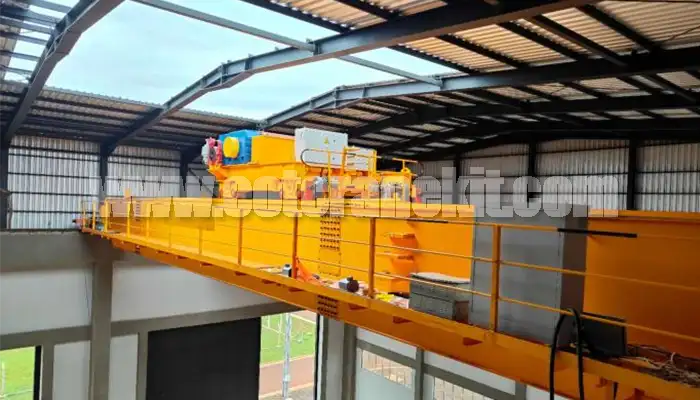
Latest project
150 Ton Overhead Crane Installation Feedback – Paraguay Case
QDX 150 ton overhead crane in action in Paraguay. Installation photos, video, and client feedback show performance, safety, and heavy-lifting efficiency.
Free consultation to Confirm Parameters & Specifications and Get
Latest Crane Price & Crane Rate.
- Types of overhead cranes : _______?
- Optional: Overhead travelling crane, goliath gantry crane,Slewing jib crane, Single girder or double girder crane,small portable crane or kbk crane, etc.
- Capacity of overhead crane: _______?
- Optional: 0.25ton, 0.5 ton, 1 ton, 2 ton, 3ton, 5 ton, 10 ton,15ton, 20ton, 25 ton, 30ton,35ton, up to 550ton, etc.
- Crane span & lifting height : _______?
- Crane travelling length : _____?
- Control of overhead crane:_______?
- Optional: pendant/ remote/cabin control
- Voltage supply of overhead crane:_____?
- Eg,: 380V50/60HZ,3Phase or others,etc.
- Application/usage of crane:_______?
- Eg,: Steel mill, ,injection mold, cement,stone, concrete,granite, general manufacturing, etc.
Just leave a message via the contact form and our hoist and crane engineer will contact you with in 24working hours.
Get In Touch
